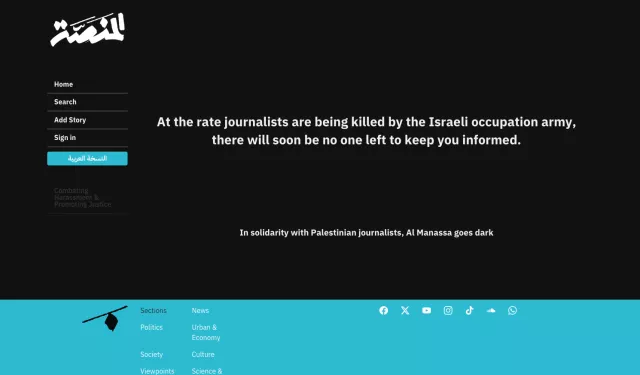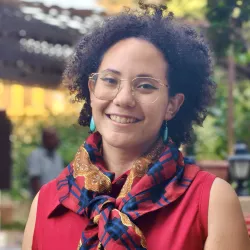
World media shrouds in black for Gaza journalists
Yesterday, more than 250 media organizations across five continents replaced their usual headlines with blacked-out front pages and banners in a rare, coordinated protest against Israel’s killing of journalists in the besieged Gaza Strip.
The global protest followed months of appeals by press freedom groups and news agencies urging Israel to lift its ban on international journalists entering Gaza and to halt its attacks on Palestinian press workers.
From major capitals to smaller communities, outlets in more than 70 countries united in an unprecedented show of solidarity—a solemn “blackout” honoring colleagues in Gaza. At Al Manassa, we stood proudly as part of this unified front, a testament to the shared conviction that journalism must not become a casualty of war.
The campaign, organized by Avaaz and Reporters Without Borders/RSF, reflected a growing consensus among regional and international media that traditional diplomatic and advocacy efforts had so far failed to protect journalists on the ground.
A protest of silence
The protest was as powerful as its purpose, tailored to each medium to amplify the message. Print newspapers featured blacked-out front pages — a visual representation of the informational void. Online news sites, including ours, displayed stark black banners or blank homepages.
TV and radio, including Al Jazeera and RTV Slovenia, interrupted programming to deliver the unified statement — in some cases broadcasting it over a black screen or the ticking of a metronome. The action was more than a plea for protection; it was a collective act of resistance against a war on journalism itself.
Before the campaign, journalists across the world had issued open letters, held press conferences, and lobbied governments to pressure Israel to stop the killings and allow international media access to Gaza.
Since the start of the war on Gaza in 2023, foreign journalists have been barred from entering the territory. Palestinian reporters —often working with minimal protection and under constant threat— remain the only journalists documenting the destruction from inside the Strip.
“At the rate at which journalists are being killed in Gaza by the Israeli army, soon there will be no one left to keep the world informed,” said RSF Director General Thibaut Bruttin. “This is not only a war on Gaza, it is a war on journalism itself.”
The death toll among journalists in Gaza has reached at least 247, making it the deadliest period for media workers in any single conflict zone on record.
“In this war, Israel is not just attacking buildings —it is dismantling the infrastructure of truth,” said David Pontes, editor of Portugal’s Público, in an interview with LUSA.
A blackout across borders
Blackened front pages stretched across the globe. From national broadcasters to independent dailies, newsrooms in Europe, Latin America, Africa, the Middle East, and Asia joined the initiative. Outlets voiced outrage not only through visual protest, but also in editorials that echoed a shared alarm.
The Irish Times described the killings as “a calculated campaign to silence those who bear witness,” warning that journalism in Gaza had become “a frontline profession without armor.” In defense of the often-maligned Gaza journalists, it added, “Their reporting has often been corroborated by satellite imagery, humanitarian agencies and by the testimony of survivors. The credibility of these journalists rests on a firmer foundation than the evasions of official spokespeople.”
In Malta, Times of Malta stressed the implications of global silence: “In the face of irrefutable evidence of state-sanctioned criminality, the siege of Gaza thus also becomes the siege of the media. When there is no one on the ground left to witness and report to the outside world what is happening, the truth dies too.”
The Guardian listed the names of Palestinian journalists killed since the war began, asserting that “The names on this list not only constitute lost lives, futures and grieving families, but the loss of a generation of journalists killed doing their jobs in the most frightening and devastating of environments and whose bravery and dedication to covering this conflict cannot be replaced.”
Momentum behind the blackout extended beyond individual outlets. More than 30 press unions and regional journalism associations endorsed the campaign, lending institutional weight to its message. These included the International Federation of Journalists/IFJ, the Latin American Federation of Journalists/FELAP, and Italy’s National Press Federation/FNSI, each calling for accountability and protection for journalists under fire.
In Dhaka, Bangladesh, the Drik Gallery hosted an exhibition honoring Palestinian journalists killed in Gaza, echoing the protest’s demand for justice.
Solidarity within newsrooms
Journalists around the world went to great lengths to join the campaign. While many media organizations officially endorsed the blackout, others expressed solidarity from within newsrooms, regardless of institutional alignment.
In France, journalists' associations from roughly 40 editorial offices, including Courrier International and France24, publicly declared their independent support for the campaign. In a joint press release, they affirmed their solidarity with Palestinian journalists and condemned the deadly conditions facing reporters in Gaza. “This was not a political decision,” they said. “It was a professional obligation.”
Israeli officials and media watchdogs respond
Israel’s foreign ministry condemned the blackout, describing it as a “pre-scripted political manifesto against Israel”, adding “This is not journalism. This is politics.” The government maintains that it does not deliberately target journalists. PM Benjamin Netanyahu, following the deaths of five Palestinian journalists in a single airstrike, described the incident as a “tragic mishap.” Pro-Israel media watchdogs also launched sharp critiques. HonestReporting called the blackout “a failed media stunt” that “violated journalism to demonize Israel.”
CAMERA UK described the protest as an “NGO echo chamber” reinforcing “anti-Israel narratives under the guise of press freedom.” Both groups accused major outlets, including The Guardian, of distorting public understanding by omitting the role of Hamas in the conflict.
Now, as the blackout fades from screens and front pages, what remains is a resounding call for accountability, not only for the journalists Israel has already killed in Gaza, but for the future of press freedom everywhere.
In a conflict where truth itself has become a target, the message from more than 250 media institutions was clear: journalism must be protected, not punished. Without independent reporting, there can be no transparency, no justice, and no hope for those living, and dying, in the shadows of war.
